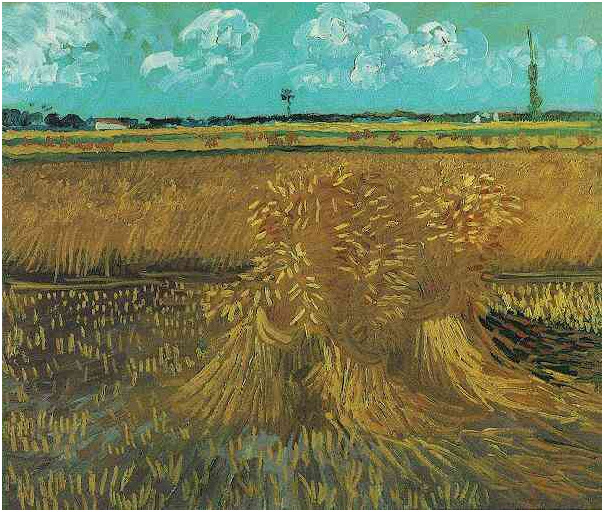From May to October 2008 the Albertina Museum in Vienna presented Vincent van Gogh from an entirely new perspective: the show unites both the painter and draughtsman Van Gogh, and its 150 works illustrate how much the artist’s expressive brush work in the paintings was prepared by his dynamic draughtsmanship.
Although Van Gogh, who described the hardship of peasants and workers out of a feeling of sympathy, had originally wanted to become a draughtsman and illustrator, he finally was to revolutionise the art of his century as an artist obsessed with colour, freeing it from the principle of the imitation of reality, as well as from the academies’ dictates of idealness. After he moved from the Netherlands to Paris in 1886, and even more so during his two last years in southern France, Van Gogh’s palette brightened notably. The brownish hues of Salon painting suddenly gave way to the purity of glistening colours. This new colouristic intensity resulted from the artist’s immediate perception of things – he was now working outdoors, in the scorching sunlight of Provence, where he directly confronted himself with his motifs.
Nevertheless, Van Gogh’s original desire to be a draughtsman had an impact on the way he dealt with colour and applied it to the canvas. By the time of his suicide in Auvers in 1890, a comprehensive and intensive drawn oeuvre had accumulated; the drawings and watercolours influenced Van Gogh’s painting style profoundly, and it became a personal idiosyncrasy of his that he drew with the brush he had previously dipped into the paint, or that he applied the expressive coloured lines and dots to the canvas directly from the tube. The large, highly finished pen drawings and watercolours are equal in artistic accomplishment to Van Gogh’s paintings in all respects.
The Albertina’s Van Gogh exhibition did not distinguish between the painter and the draughtsman. In fact, the comprehensive show, assembling 50 paintings and 100 ofthe most impressive watercolours and drawings from more than 60 lenders around the globe, intended to demonstrate the interdependence between painting and drawing, as well as the correlation between Van Gogh’s new approach to colour and the expressive linear style he developed, both of which form an irresolvable creative unity.
This exhibition was compiled in collaboration with the Van Gogh Museum in Amsterdam and is the largest presentation of the artist’s oeuvre since the jubilee exhibition in Amsterdam in 1990. Moreover, it was the first Van Gogh show in Austria for more than half a century. Lenders such as: Van Gogh Museum (Amsterdam), Kröller-Müller Museum (Otterlo), Metropolitan Museum of Art (New York), Musée d’Orsay (Paris), National Gallery of Art (Washington), Guggenheim Museum (New York), Puschkin Museum (Moskau), Armand Hammer Museum (Los Angeles) and private collections.
Catalogue

Works in the exhibition:

Kröller-Müller Museum, Otterlo, The Netherlands Still Life with a Plate of Onions, 1889

The Armand Hammer Collection, Los Angeles Pine Trees in the Asylum Garden Saint-Rémy, 1889

The National Museum of Art, Architecture and Design, Oslo Peasant Woman, Kneeling, 1885
.jpg!Blog.jpg)
Stiftung Sammlung E. G. B & Z Bridges across the Seine at Asnieres, 1887

Van Gogh Museum, Amsterdam (Vincent van Gogh Foundation) Entrance to the Moulin de la Galette, 1887

Van Gogh Museum, Amsterdam (Vincent van Gogh Foundation) Self-portrait with Straw Hat, 1887
.jpg!Large.jpg)
Van Gogh Museum, Amsterdam (Vincent van Gogh Foundation) Fishing Boats on the Beach at Les Saintes-Maries-de-la-Mer, 1888

Van Gogh Museum, Amsterdam (Vincent van Gogh Foundation) The Harvest, 1888

Trustees of the National Gallery of Art Harvest - The Plain of La Crau, 1888

Pommersches Landesmuseum, Greifswald Lane near Arles (Side of a Country Lane), 1888

Los Angeles County Museum of Art Portrait of the Postman Joseph Roulin, 1888

Detroit Institute of Arts Portrait of the Postman Joseph Roulin, 1888

Van Gogh Museum, Amsterdam (Vincent van Gogh Foundation) The Sower, 1888

The Metropolitan Museum of Art, New York Street in Les-Saintes-Maries-de-la-Mer, 1888

Honolulu Academy of Arts Wheat Field with Sheaves, 1888

Hammer Museum, Los Angeles Hospital at Saint-Rémy, 1889

Kasama Nichido Museum of Art, Japan A Path at Saint-Rémy, 1889

Kruller Museum, Otterlo, The Netherlands Still Life with Drawing Board, Pipe, Onions and Sealing-Wax, 1889

National Museum & Galleries of Wales, Cardiff Rain in Auvers, 1890

Dallas Museum of Art Sheaves of Wheat, 1890